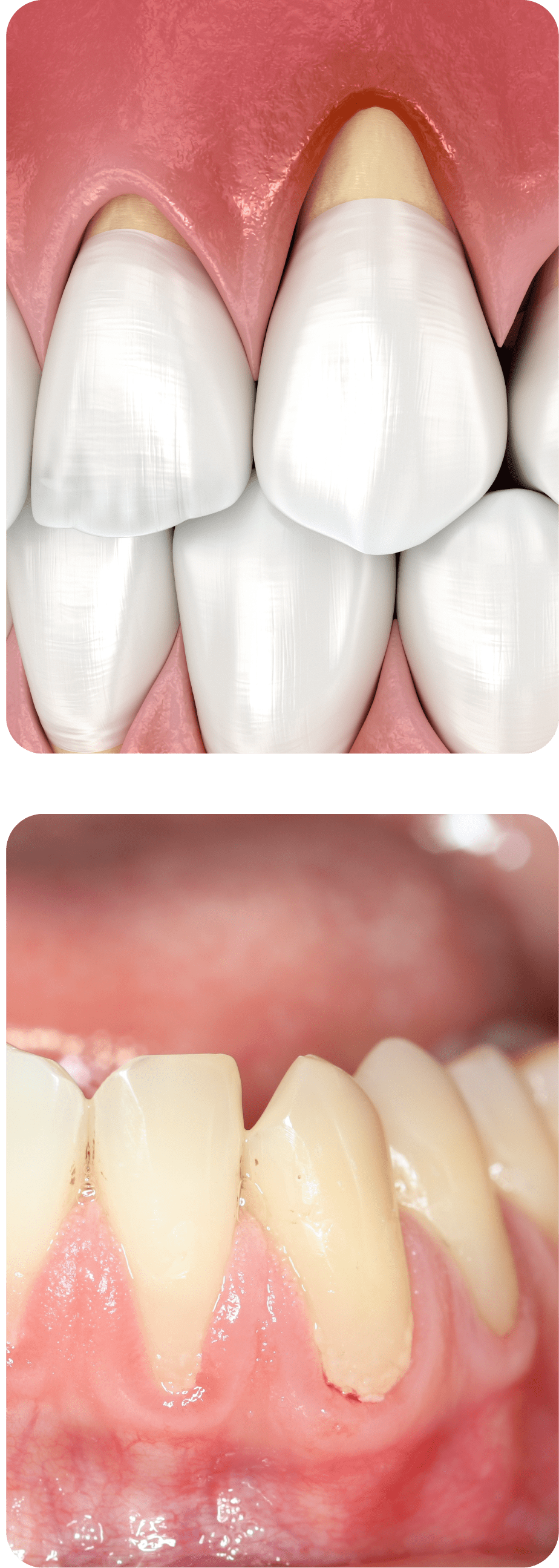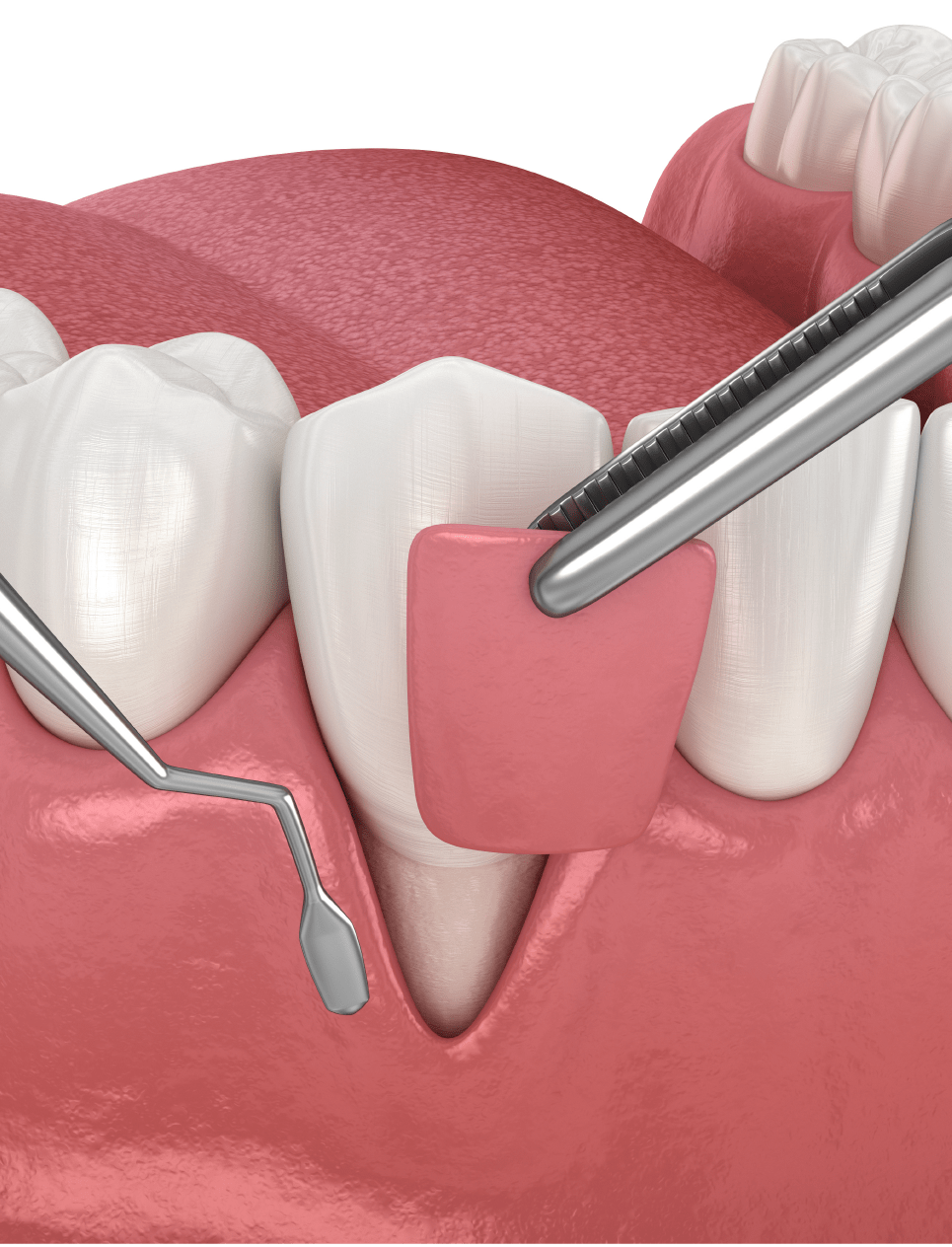Gum Grafting in Augusta GA
Gum Grafting
OR CALL (706) 868-0246
The Soft Tissue Graft is used to cover unattractive tooth roots, reduce gum recession, and protect the roots from decay. Most importantly this procedure regrows the gum and bone to prevent tooth loss.
When a tooth erupts into the mouth, it should be surrounded by a layer of bone and a normal thickness of gum tissue. Nature designed this tough gum tissue, called attached gingiva to resist bacterial penetration as well as the forces of chewing food, brushing, etc.
When, the body loses gum tissue around the tooth root, recession of the gingiva (gum tissue) occurs. For the gums to recede, bone loss must also occur. With recession, the gums lose the natural defense against both bacterial penetration and trauma. When gum recession is a problem, gum reconstruction using soft tissue grafting techniques is usually the best option.
Most recession is caused by a combination of several factors. Recession is also something you may be predisposed. Meaning recession may run in your family from genetically inherited factors.

Causes of Gingival Recession: Thin, Fragile Gum Tissues Vary & May Occur from:
- Prominent Roots of the Teeth or Thin Bone. Crowding of teeth can create a prominent root and result in gum recession.
- Muscle Attachments (Frenum) pulling on the gum tissue. The case to the right shows a frenal pull with gum recession.
- Periodontal Disease and Periodontal Treatment can cause recession. Most of the time this cannot be fixed. Our doctors can let you know if your situation can be treated.
- During or After Orthodontic Treatment – recession can occur from teeth being larger than the size of your jaw bone (tooth arch size discrepancy). This creates prominent root(s) and results in recession during or after orthodontic treatment.
- Trauma (physical damage) to the Gums – trauma to the gums can occur from several sources including:
- Toothbrush Abrasion (Cervical Abrasion) Cervical or toothbrush abrasion occurs when patients cause their recession. This results from brushing too hard, using a tooth brush with medium or hard bristles (you should always use a soft bristle tooth brush), or using an abrasive toothpaste (baking soda or tooth whitening toothpastes are like “scouring powder”). Cervical abrasion can strip away the gum and bone supporting the teeth as well as create notches (grooves) in the root surface.
- Gum Damage from a Removable partial denture If a removable partial clasp gets too close to the gum tissue they can “strip” the gums away and cause recession. The example to the right is from a tooth that lost gum tissue from a partial clasp. See the recession to the right treated and other treatment examples.
- Gum Damage from a Lip or Tongue Piercing– If a piercing rubs the gum tissue this can cause gum recession by “stripping” the gums away. Soft tissue grafting can correct gum recession as long as the recession does not have severe bone loss and as long as you do not continue to wear your piercing.
How Do You Treate Gum Recession?
When there is only minor recession, some healthy gingiva often remains and protects the tooth, so that no treatment other than modifying home care (brushing and floss) is necessary. However, when recession reaches 3 millimeters (mm), repair may be necessary.
In addition, gum recession can result in root sensitivity to hot and cold foods as well as an unsightly appearance of the gum and tooth. When greater than 3 mm, gum recession can predispose to worsening recession and expose the root surface, which is softer than enamel, leading to root cavities and root gouging (also called root abrasion or cervical abrasion (see above). A gingival graft is designed to solve these problems.
The Below Picture Shows Root Cavities Treated with Soft Tissue Grafting.

What Are Soft Tissue Grafting Procedures Like?
Gum tissue is borrowed from four different sources. One, a thin piece of tissue is taken from the roof of the mouth. Two, if there is extra tissue around the upper wisdom tooth area, sometimes this can be used for the graft. This extra tissue can create a pseudopocket around the tooth in front of the wisdom tooth which can lead to periodontal disease. Commonly removing this tissue solves two problems – the need for a graft and the need to prevent future periodontal disease on an upper back tooth. Three, Gum tissue can also be gently moved over from adjacent areas to provide a stable band of attached gingiva around the tooth.
Soft Tissue Grafting Is Highly Predictable
Gum grafting is 95% successful. The first goal of soft tissue grafting is to produce a stable healthy band of attached gum tissue around the tooth. This increased thickness of gum tissue prevents further loss of gum tissue and bone and helps you to keep your tooth/ teeth. In fact, gum grafting has been shown to regrow up to 50% of the bone around a tooth. The second goal is to cover the exposed portion of the root as much as possible. This can be aesthetically pleasing. If teeth are sensitive, then soft tissue grafting may cover the root to prevent root sensitivity.
Other Names for Soft Tissue Grafting:
Soft Tissue Grafting, Gum Grafting, Gingival Grafting, Free Gingival Grafting, Sliding Pedicle Grafting, Subepithelial Connective Tissue Grafting, and Gingival Augmentation are all procedures to treat Gum Recession.


